3d Printed 'cork' Bottle Stopper
by mrsmerwin in Workshop > 3D Printing
1506 Views, 6 Favorites, 0 Comments
3d Printed 'cork' Bottle Stopper
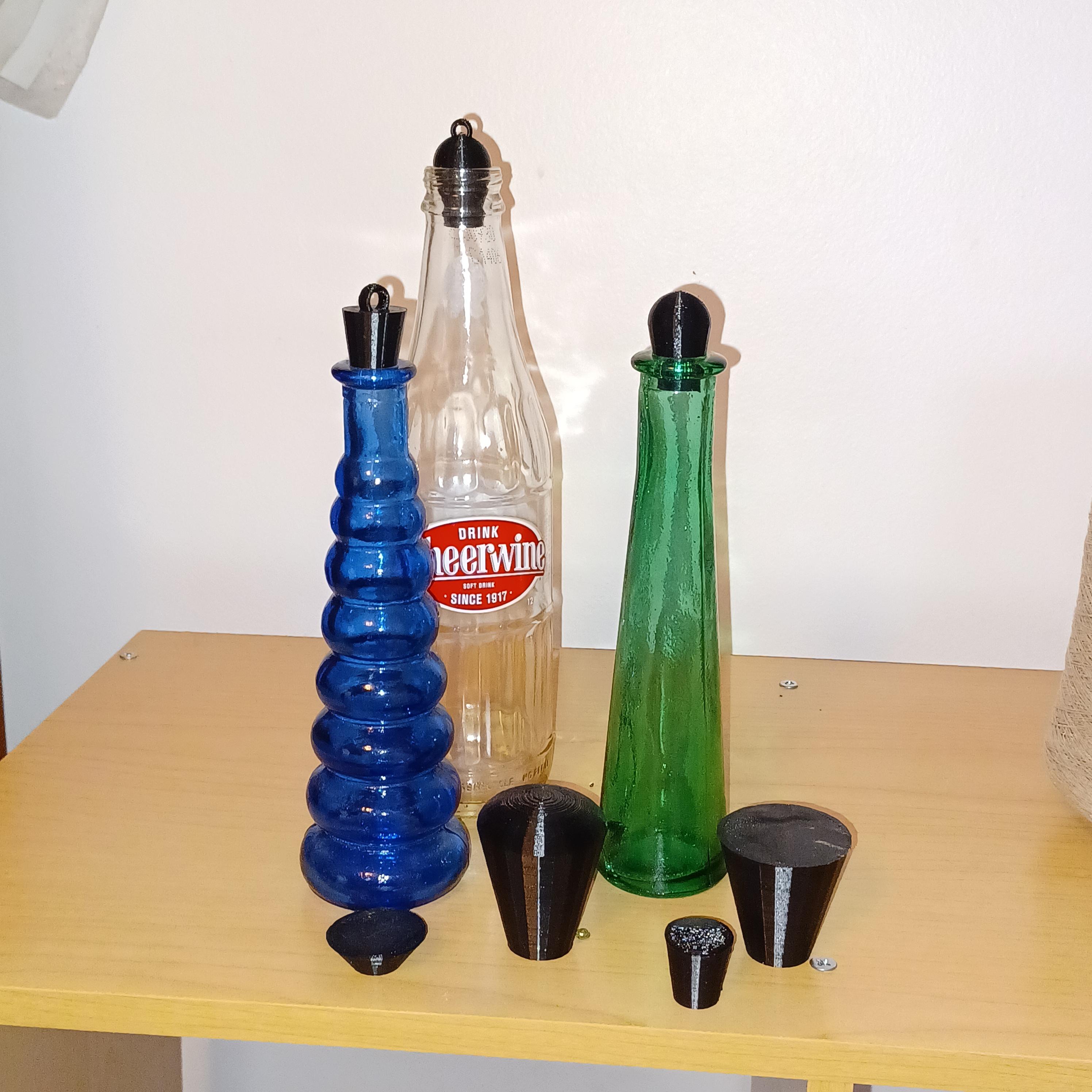
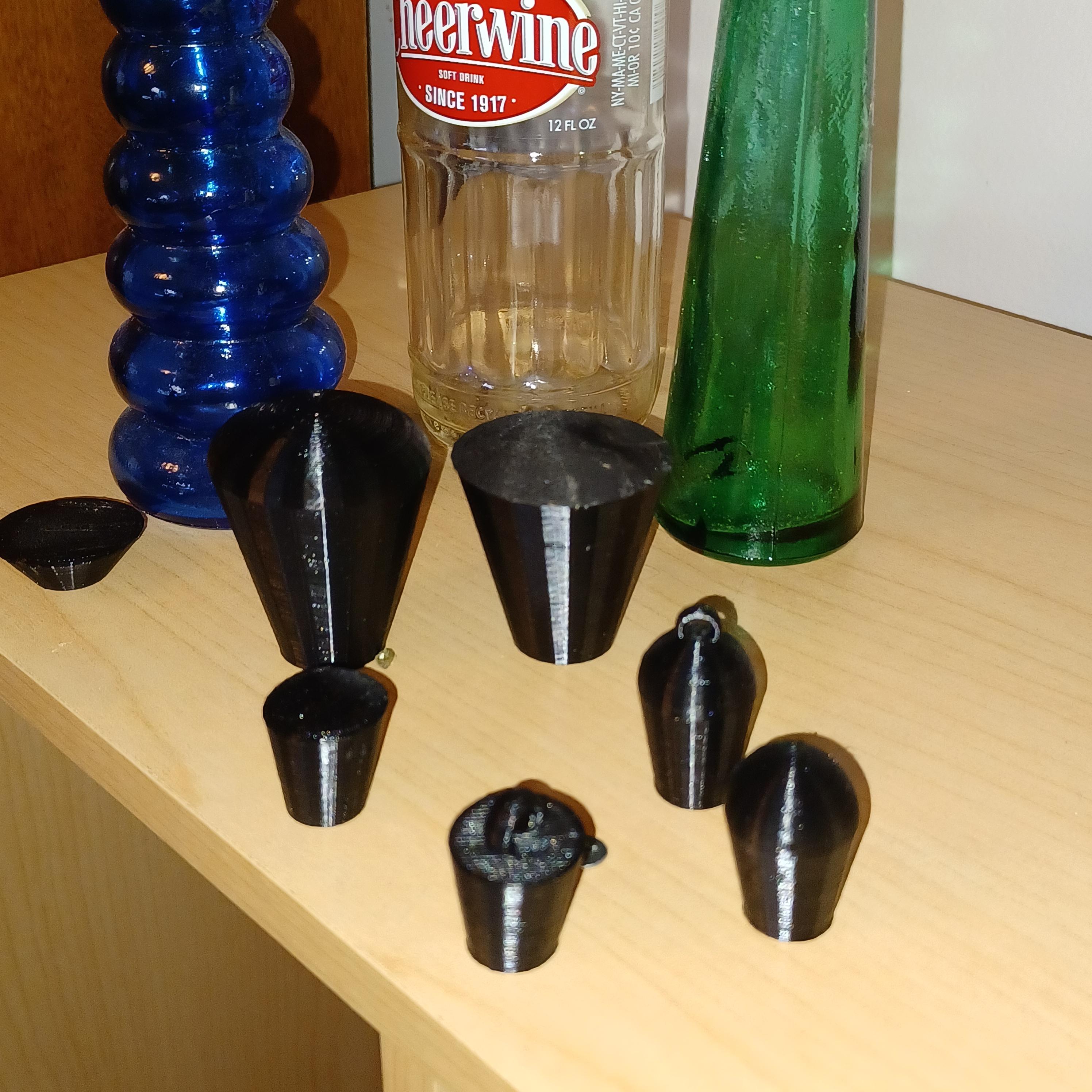
This is a combined introduction to 3d design and basic geometry lesson.
I was appalled when I heard a high school student express her opinion (name withheld intentionally) that geometry was the most useless math class ever. After I worked with her for a while, she admitted that geometry was actually extremely useful, but it left me thinking. She cannot be the only student that feels this way. I must admit that after teaching for 30 I was surprised that I heard this sentiment expressed only once. I assume that the others were too polite to tell me to my face.
I have always believed that projects in geometry allow students to explore the concepts of geometry in more practical ways than textbook work. I used weekly projects to expand on the normal classroom 'book' learning. This project is intended to incorporate the geometric vocabulary the students are learning in the classroom with hands on experience in the computer lab.
Many of my fellow teachers were hesitant to incorporate projects into their teaching. It involves giving up some of the control you have over the learning process to allow the students to control it themselves. I call this 'play time' and the students are not always comfortable with it either.
If you are inexperienced with using a CAD program and using projects to teach geometry, give this a try from home and see how easy it is. Then go back to your school and book some time to take your class to the computer lab. When you have practiced with Tinkercad at home, introduce it to your students in the classroom. Find out if any of your students have used it (or a similar program). I like to start a day or 2 before the lab day so they have some idea what they will be doing.
If you are lucky enough to have a kid or 2 to help you, great! Use them. Let them know that you are a student too and that you expect them to teach you some too. From my experience, you will spend a bit of time asking them to slow down so that you can grasp what they are saying. (Really helps the teacher remember what it is like to be the confused student sitting in the classroom with the teacher talking way too fast and trying to learn when it is all too confusing and frustrating.) I always learn so much more from my students than I could have ever figured out on my own.
Supplies
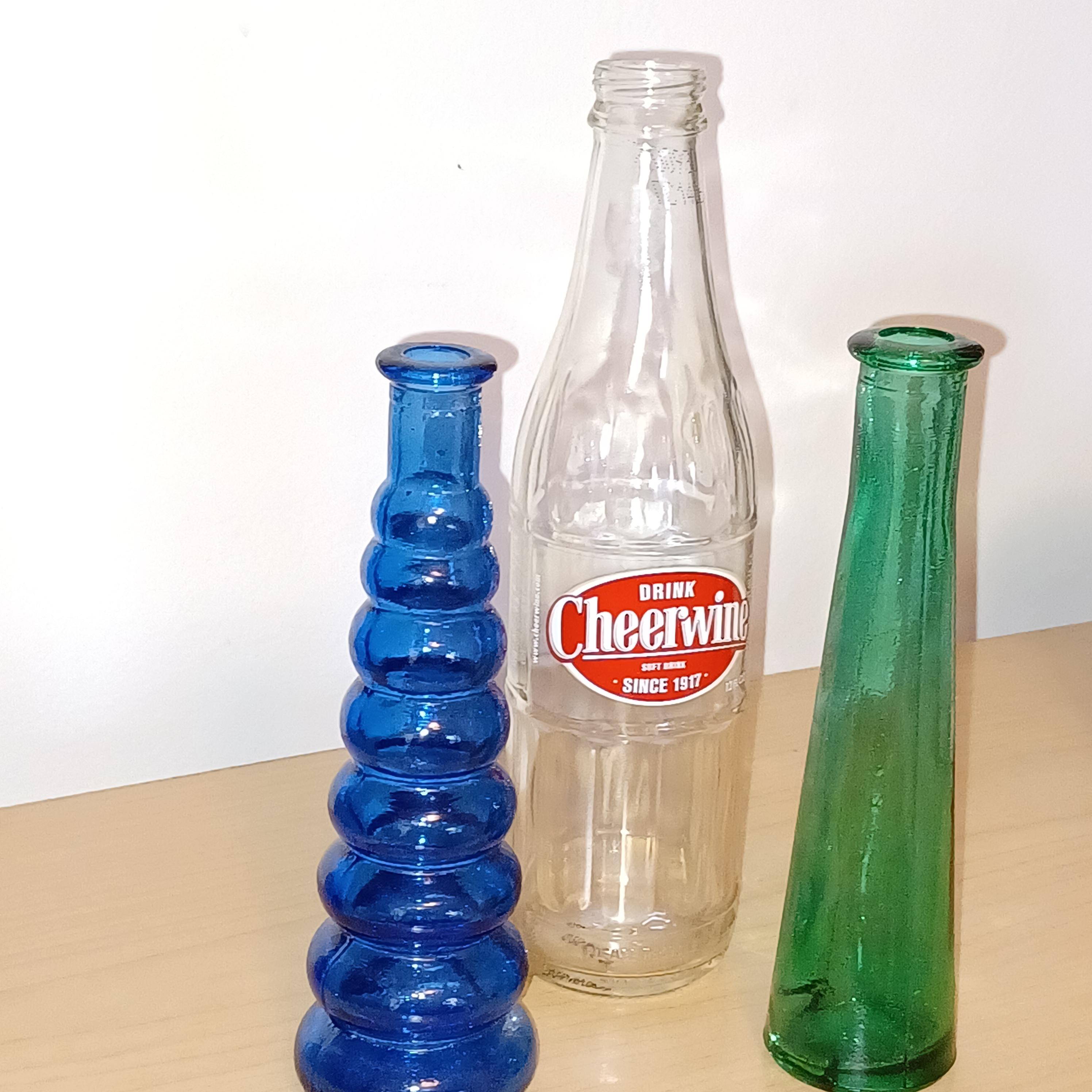
- assortment of bottles (encourage students to bring their own as they will have a finished stopper for it at the end but I also bring an assortment for them to choose from if they forgot)
- metric measuring tools (rulers are good enough but calipers are fun too. Borrow them from a science teacher or 3d print a few pair.)
- computers with internet access (one per student, or in a pinch, one per group of students)
- 3d printer (I am using an Ender 3 v2)
- flexible filament (I used TPU which is a bit finicky but worth trying)
PROBLEM TO SOLVE: This bottle needs a stopper. (This actual problem occurred one summer day and I immediately thought--this would make a great geometry project.) I had several bottles at home that needed caps. I realized that I could go to the store and buy corks, but corks come in sizes. Once you finally find a store that carries corks, you still must find the right size for the bottle. This is a lot of work. I am a math teacher and I know that the shape of a cork is just a truncate cone. This is not too hard to make. I have access to a 3d printer, and I actually have a spool of TPU filament. WOW! I have everything I need to make my own corks in whatever sizes I need. I can even make them with unique shapes on top.
You may be able to come up with a different 'problem' for your students to solve. My suggestion is:
- Keep it small. Prints take a long time for the printer to generate and if you have a lot of students...well you do the math.
- Keep it simple. The first cad drafting project should not frustrate the students into never wanting to try this again.
- Keep it useful. If they do not care to keep their project at the end, they will lose that tangible reminder of what they accomplished. This has more impact than most of us realize. Ask a student 10 years after they graduate to tell you what they remember from class.
Measuring the Bottle
I have tried for years to encourage the use of the metric system whenever possible with my students. Calculations are so much easier if you do not need to mess around with fractions. This is a perfect opportunity to reinforce this idea, Tinkercad is already set to use mm as its default so that is what I have the students use.
A ruler is a good enough tool in order to get the necessary measurements but if you check with the science department, you may find that they have a class set of calipers. It is really easy to measure inner diameters with these, but you may find that most of the class has never had the opportunity to use these tools. Be prepared to demonstrate their use.
Some students know intuitively that you need to measure the inner dimension of the bottle opening but this is not obvious to all. They also need to measure at the widest part of the circular opening. I encourage them to measure more than once to make sure that they are using the largest measurement--the actual diameter and not a chord. This works well in small groups so that they can check each other's work. Have each student measure their own bottle and then the bottle of each member of the group. Perfect measurements are not absolutely necessary for this project, but it does not hurt to put in the effort.
In the Computer Lab
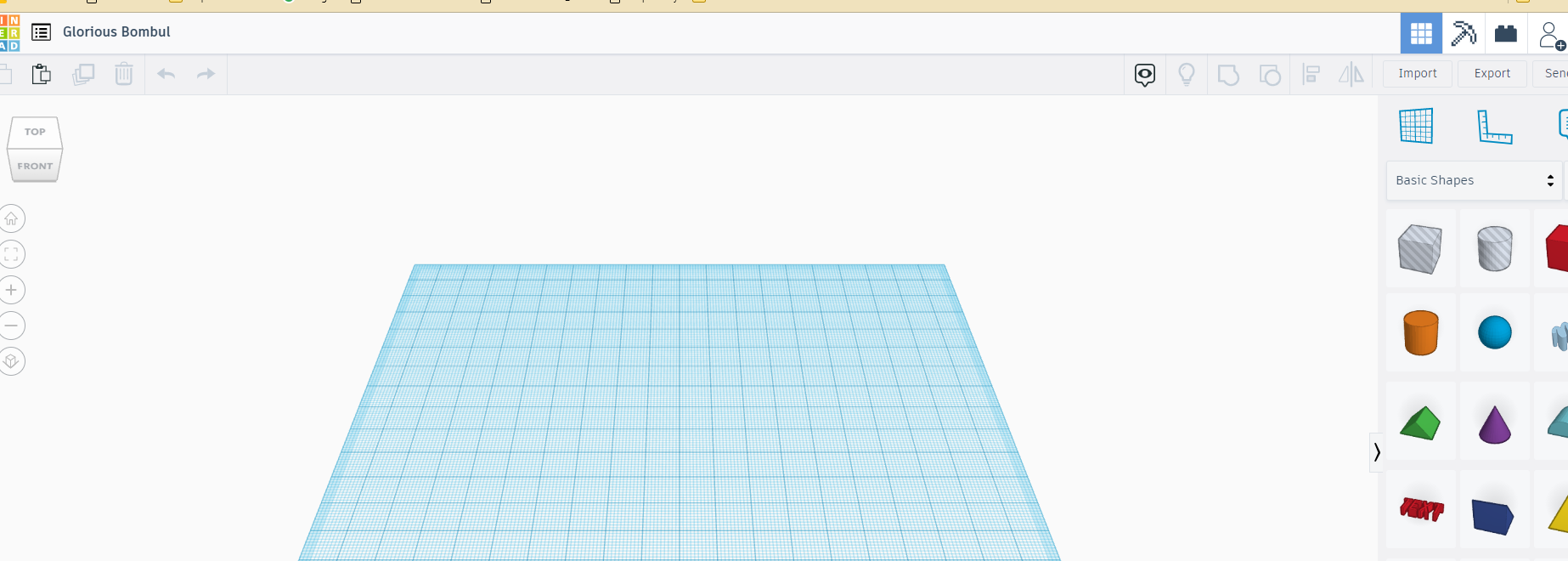
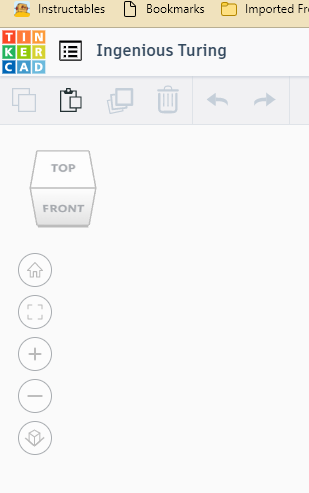
This should be something that takes only one day of lab time. If the students are familiar with Tinkercad, it will probably take less time. I am assuming that this lab experience is early in the term and probably the first time most of the students have played with Tinkercad. Experienced students can be encouraged to create a more elaborate 'cork' or assist other students with less experience.
Each student (or group) needs to open their own profile. If you, the teacher, have recently done this for yourself, you will be able to walk the class through the process. I like to create an alternate profile for myself at home a few days before doing this with a class so that I remember all the details, and everything is fresh in my mind.
Once everyone is in and looking at the blank build plate, you need to help them overcome the panic that comes from staring at a blank page. In the upper left corner of the screen is a little 3d cube. Click on this and drag on it. Watch what happens to the build plate. This allows you to see your drawing from different angles any time you want to. The plus and minus circles below it will allow you to zoom in and out.
Locate the basic tools on the right-hand side of the screen. I used the cone, the prism (box), the hemisphere, and the torus. Other than the cone and something to remove the point from the top of the cone, the other shapes used are up to the imagination of the students. Allow yourself and your students a chance to play with what is available. If students have access to the internet at home, they will be able to open these same files there and 'tinker' from home on the same project until they are satisfied.
My steps in this process of playing are found in the next few steps. If you are asking your students to make some other small but useful item, your steps will look a bit different.
Drawing a Cone
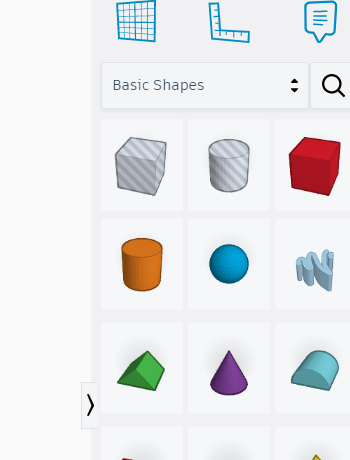
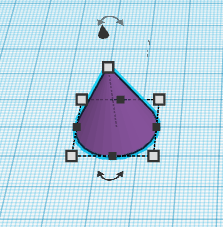

The cone is one of the basic shapes provided by Tinkercad. Click on it and drag it onto the build plate. Magically, you have a cone. Click on that cone and you can see the size of the cone. This is where the measurements of the bottle come in. The bottom of your cone will become the top of the cork. Make sure that the measurement is a bit larger than the bottle measurement.
My bottle measured about 14 mm. I decided to make the top of my cork 20 mm. This just happens to be the default for the cone in Tinkercad but if it needs to be changed, remember that it needs to be changed in both the x and y directions. Demonstrate this for the class by only changing one dimension and rotate the build plate (upper left corner of the screen) to show them that it is no longer circular.
Resizing can be done by dragging the white box or clicking on the white box to freeze the visible measurements. Then you can click on one measurement at a time and type in the number you want. In the bottom right corner of the screen, you can change the 'snap grid' increments. This might make the drag method work more easily.
There is a white box above the others on your cone. This controls the height of the cone. For our purposes here, this will determine the amount of slant to the sides of our stopper.
Play around until you have it the way you want it. Make sure that you allow time for your students to play too.
Truncating the Cone
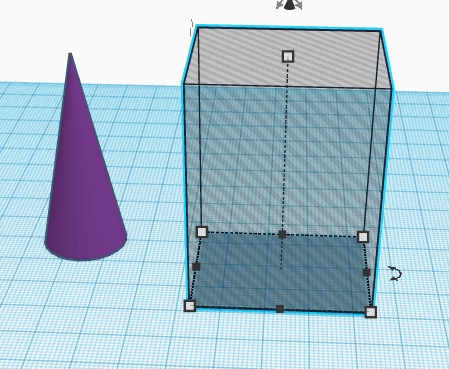
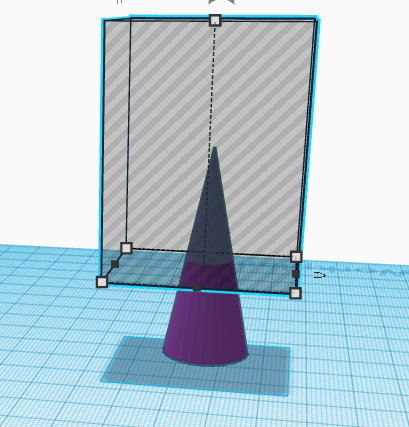
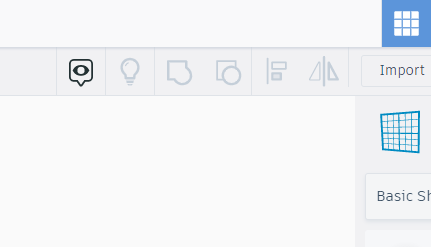
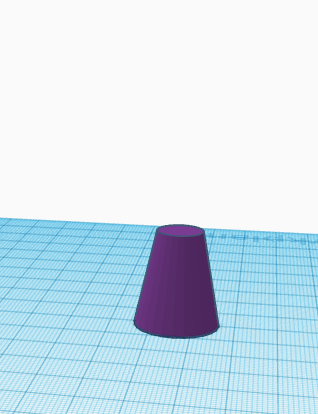
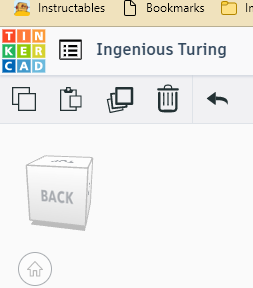
I like to use proper geometric terms even if it is early in the term and 3d shapes do not appear in the book until much later. This gets them udsed to hearing weird new words and asking if they are not familiar with them.
Truncate--to literally just cut off a chunk of a shape. We use this word with numbers in my class too. It that case we are 'cutting off' the extra 6 or 8 digits of an answer that the calculator displays. I have to tell my students that I really do not want to read "4.2473726648" as an answer on a test. I much prefer that they round or truncate their answers. This leads to a discussion of the word 'truncate' usually in the first few days of a term.
In this case, we can use a prism (a.k.a. box shape) to cut off the point of my cone. The grayed-out prism will remove whatever it is merged with. I click on the build plate to start the prism and then resize it bigger than the dimensions of the cone. Precision here is not important.
Raising the prism off the build plate took me a bit to get comfortable with. When you click on the prism, there is a black triangle hanging above the object. This will lift the object. Drag it up. You will notice that a white box with a number in it keeps changing as you drag. This tell you where the bottom edge of the object is with reference to the build plate. A negative number indicates that it is below the build plate. (Play around. Rotate the build plate and see things from different angles. Encourage your students to do this too.)
You need to move the prism so that it is above the build plate by the amount that you want the height of your stopper to end up. Don't worry about where on the plate it is at this point. Just worry about the height. Remember that there is an 'undo' button in the upper left corner of the screen. Also, remember that this is supposed to be fun (playing is fun) and you should breathe occasionally.
Once the prism is at the correct height, rotate your build plate so that you can see where the cone and the prism are in relationship to each other. Move one or both until you have them lined up.
Now you need to drag a box around that touches both objects. You don't have to worry about enclosing every bit of each of them. Once both are highlighted, click on the 'merge objects' button at the top right of the screen. Notice the 'un-merge' also. I find this button very useful when working on more complex designs.
You should have a truncated cone.
Fancy Top to Your Stopper?
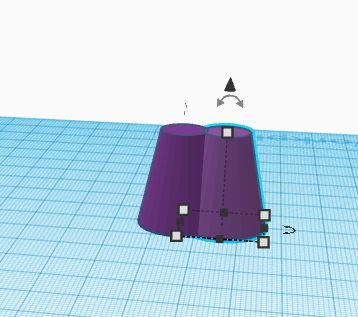
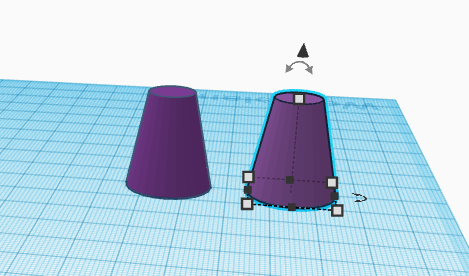
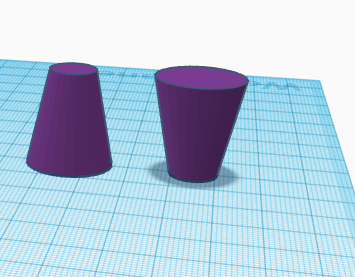
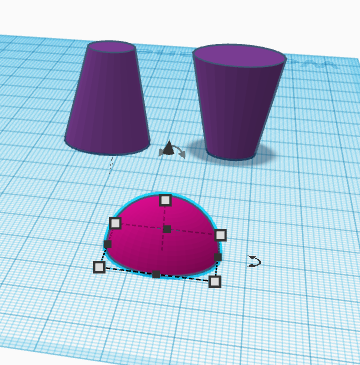
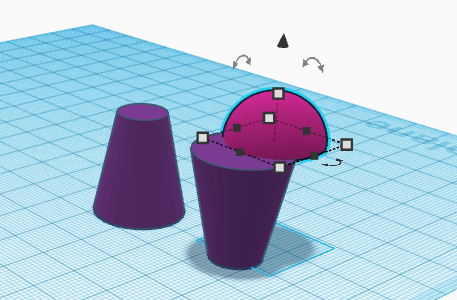
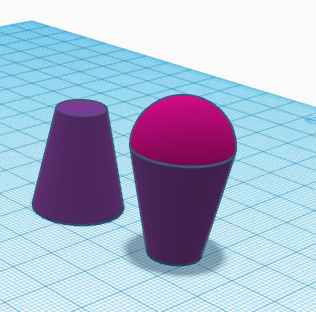
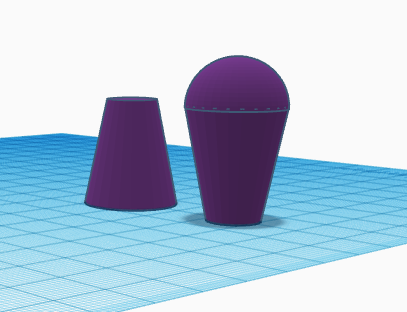
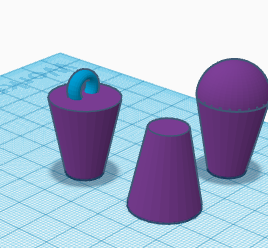
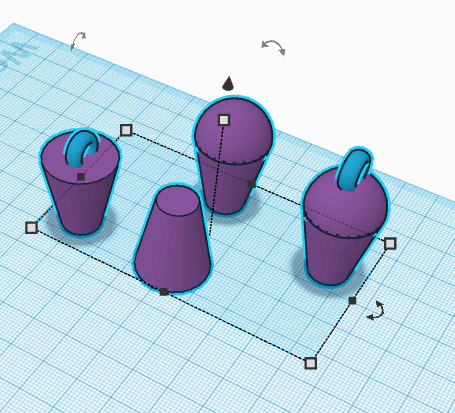
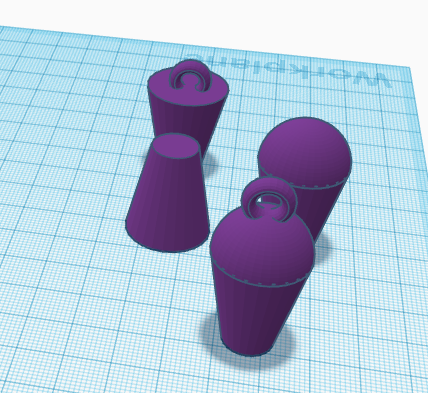
If you print right now, you have a fully functional stopper. Technically it is done.
I found it too simple, so I have to do more. Might as well learn a few more bells and whistles.
I do not want to lose what I have done so I recommend working on a copy of this finished one. If you don't like your changes, you will still have your original. Click on your stopper, and then click on the copy button (upper left corner of the screen). Click 'paste' and hit the arrow keys on the keyboard (between the shift key and the number pad on most keyboards) a few times to separate your objects on the build plate.
Highlight only one stopper. Notice there are curved black arrows hanging over the object. Click on one set of arrows. You will see the direction that you can rotate your object using that particular arrow. Click in the number box to type a number (180) for this project. If your stopper did not flip over, you used to wrong direction. Try again. If you cannot see all 3 directional arrows, rotate your build plate a bit. Keep trying until you have it right.
Sometimes, your stopper may flip below the build plate. Use the black arrow to lift it. The height above the plate needs to be zero.
I tried using a hemisphere (half a sphere) on top of my stopper--kind of ice cream cone style.
I used a torus (the donut looking thing) tipped on its side.
Then I tried combining the 2--so I have a ring on top of my ice cream cone.
If you encourage your students there is no telling what they may come up with. If this gets too elaborate, you may need to check with someone with 3d printer experience (assuming you do not have any yourself) to determine if the print is possible and if it will require supports and all that.
Remember to merge all the toppers to the actual stopper so that they become one object. When you merge objects they become the same color.
Printing
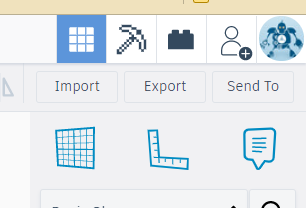
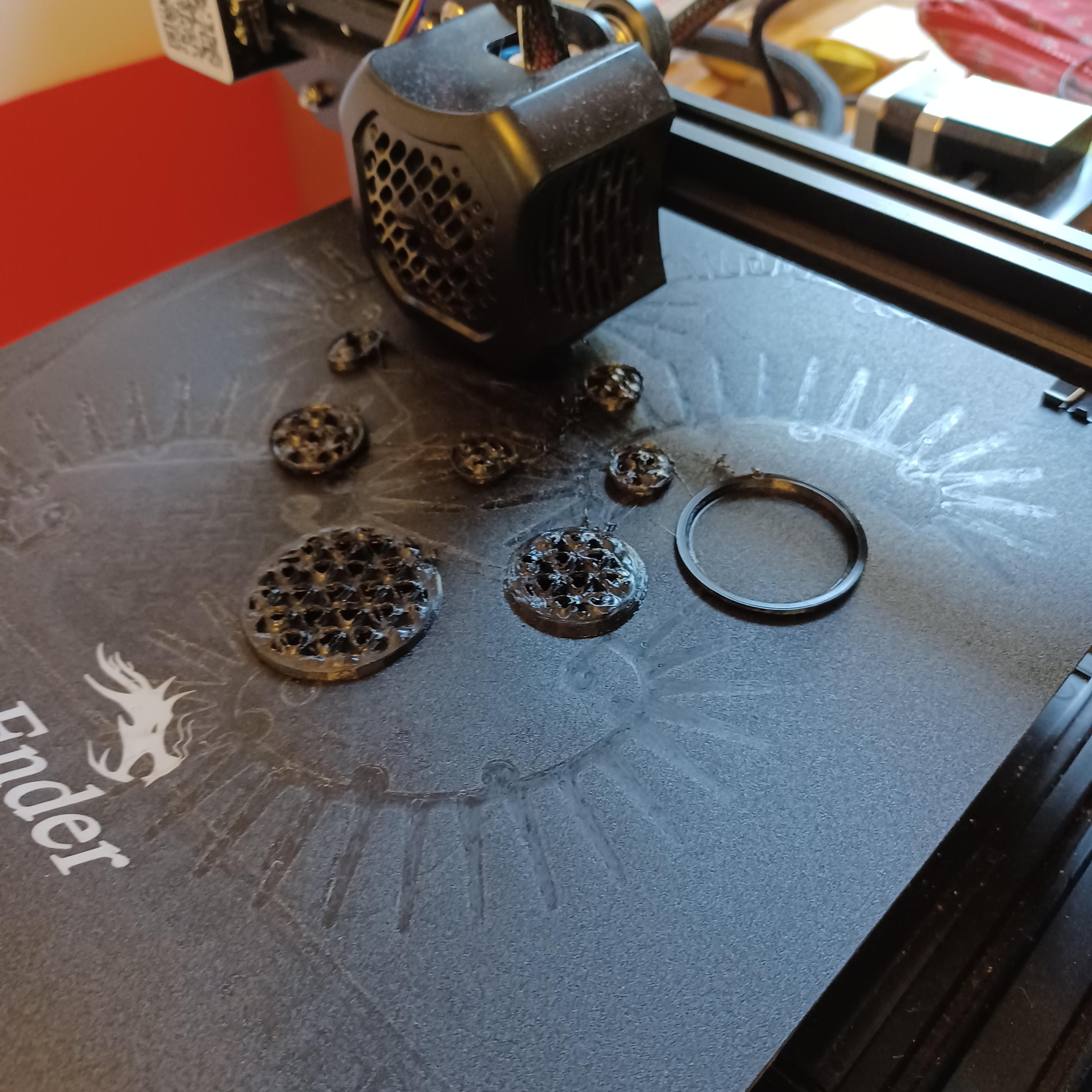
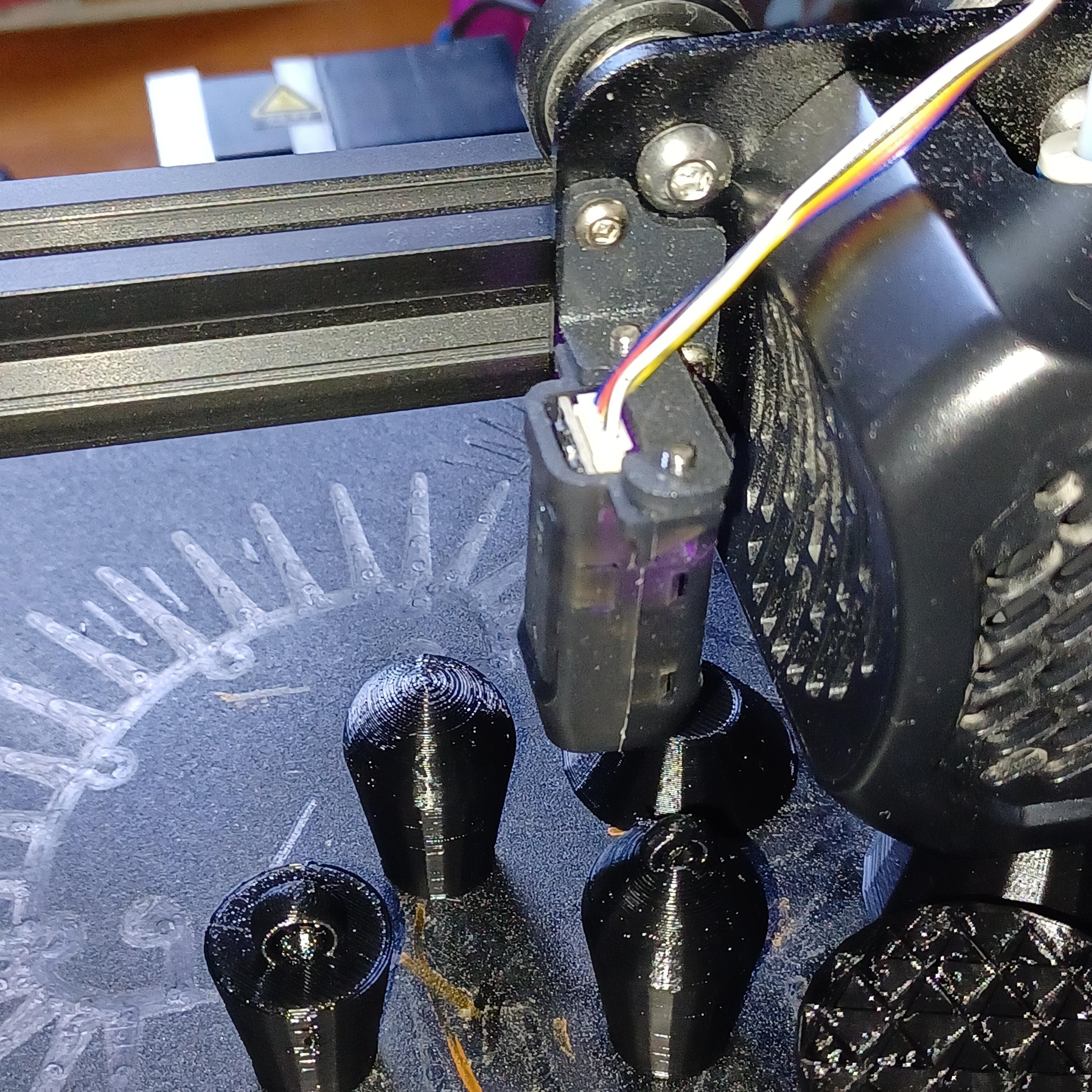
You need to make sure that nothing is selected before you click the export button (upper right on screen). If one object is selected, it is the only object that will be exported and printed. Don't ask me how long it took me to figure out why only one of my stoppers was getting exported.
Open your slicer and import the file to be printed. I am assuming that if you have a 3D printer, you already have a favorite slicer. I am currently using Cura. If you are using the school lab and the school 3D printer, there is someone you can ask about slicers and the actual printing. I think it is important for the students to be able to touch the object that they designed on the screen, if it is at all possible, so do all you can to get access to a printer.
Depending on how involved the designs are which your students produce, you may need to discuss the need for supports during the slicing process. I did use supports on my stoppers that had rings on top. It will lead to a discussion about just how much overhang the 3D printer can handle without supports.
Ideally, you can set up a 3D printer in the corner of your classroom and the students can see the layers that go into a 3D print. I have learned the geometry of several different hinges just by watching things print. It is a bit like x-ray vision. Great learning opportunity.
I printed my stopper in flexible filament (TPU) as well as ordinary rigid filament (PLA) because I wanted my students to see the properties of the different plastics.
Where Do We Go From Here?
Once kids have some experience with something like 3D design, their minds are opened to a lot of new possibilities. This may be an opportunity for you to encourage your students to try more design classes. If your school has a 3D printer in the computer lab, maybe there is also a 3D printing club (or should be). There may be design classes available at a local college or maker space.
This is an opportunity for unlimited future creativity. Maybe there are future Instructable authors in your class. This would be a cross curricular opportunity to work with the language arts teachers to encourage writing opportunities. Technical writing is not explored at all schools or with all students.
This may look very long and complicated. Once you have played for a while, you will see that you can whip up a few custom sized stoppers in just a few minutes--plus the printer time. You can also spend countless hours immersed in a complex design that, for now, only exists in your mind. And there it will stay if you are too intimidated to try something new.